1920s: Difference between revisions
m Reverted edits by 99.137.216.206 (talk) to last version by Wiki libs |
→Literature: removed * George Gershwin writes ''Rhapsody in Blue''- because it's not a work of literature |
||
| Line 132: | Line 132: | ||
* [[D.H. Lawrence]] publishes ''[[Women in Love]]'', and ''[[Lady Chatterley's Lover]]'' |
* [[D.H. Lawrence]] publishes ''[[Women in Love]]'', and ''[[Lady Chatterley's Lover]]'' |
||
* [[Virginia Woolf]] publishes ''[[Jacob's Room]]'', ''[[Mrs. Dalloway]]'', ''[[To the Lighthouse]]'', ''[[A Room of One's Own]]'' and ''[[Orlando (novel)|Orlando]]'' |
* [[Virginia Woolf]] publishes ''[[Jacob's Room]]'', ''[[Mrs. Dalloway]]'', ''[[To the Lighthouse]]'', ''[[A Room of One's Own]]'' and ''[[Orlando (novel)|Orlando]]'' |
||
* [[George Gershwin]] writes ''[[Rhapsody in Blue]]'' |
|||
* [[T. S. Eliot]] publishes ''[[The Waste Land]]'' |
* [[T. S. Eliot]] publishes ''[[The Waste Land]]'' |
||
* [[James Joyce]] publishes ''[[Ulysses (novel)|Ulysses]]'' |
* [[James Joyce]] publishes ''[[Ulysses (novel)|Ulysses]]'' |
||
Revision as of 06:08, 27 April 2010
This article needs additional citations for verification. (January 2009) |
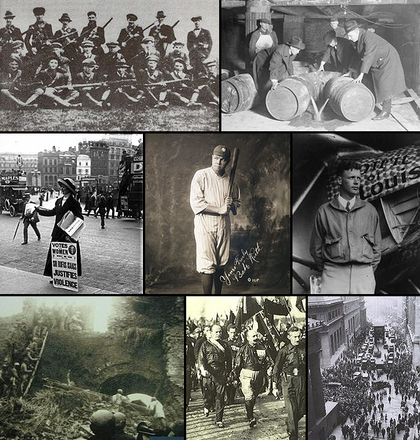
| Millennium |
|---|
| 2nd millennium |
| Centuries |
| Decades |
| Years |
| Categories |
The 1920s was the decade that started on January 1, 1920 and ended on December 31, 1929. It is sometimes referred to as the Roaring Twenties or the Jazz Age, when speaking about the United States, Canada or the United Kingdom. In Europe the decade is sometimes referred to as the "Golden Twenties" [1] because of the economic boom following World War I.
Since the end of the 20th century, the economic strength during the 1920s has drawn close comparison with the 1950s and 1990s, especially in the United States. These three decades are regarded as periods of economic prosperity, which lasted throughout nearly each entire decade. Each of the three decades followed a tremendous event that occurred in the previous decade (World War I and Spanish flu in the 1910s, World War II in the 1940s, and the end of the Cold War in the late 1980s).
However, not all countries enjoyed this prosperity. The Weimar Republic, like many other European countries, had to face a severe economic downturn in the opening years of the decade, because of the enormous debt caused by the war as well as the Treaty of Versailles. Such a crisis would culminate with a devaluation of the Mark in 1923, eventually leading to severe economic problems and, in the long term, favour the rise of the Nazi Party.
Additionally, the decade was characterized by the rise of radical political movements, especially in regions that were once part of empires. Communism began attracting large numbers of followers following the success of the October Revolution and the Bolsheviks' determination to win the subsequent Russian Civil War. The Bolsheviks would eventually adopt a policy of mixed economics, from 1921 to 1928, and also give birth to the Soviet Union, at the end of 1922. The 1920s marked the first time in the United States that the population in the cities surpassed the population of rural areas. This was due to rapid urbanization starting in the 1920s.
The 1920s also experienced the rise of the far right and fascism in Europe and elsewhere, being perceived as a solution to prevent the spread of Communism. The knotty economic problems also favoured the rise of dictators in Eastern Europe and the Balkans, such as Józef Piłsudski in the Second Polish Republic and Peter and Alexander Karađorđević in the Kingdom of Yugoslavia. The devastating Wall Street Crash in October 1929 drew a line under the prosperous 1920s.
War, peace and politics
Wars
- Greco-Turkish War (May 1919 – October 1922)
- Turkish–Armenian War (September 24 to December 2, 1920)
- Franco-Turkish War (May 1920 - October 1921)
Internal conflicts
Major political changes
- The rise of Communism following World War I.
Decolonization and independence
- Irish Free State gains independence from the United Kingdom in 1922.
- Egypt officially becomes an independent country in 1922, though it still remains under military and political influence of the British Empire.
International issues
- See also Social issues of the 1920s
- Rise of radical political movements amid the economic and political turmoil after World War I and after the stock market crash such as communism and fascism
- Kellogg-Briand Pact to end war
- Women's suffrage in multiple countries
United States
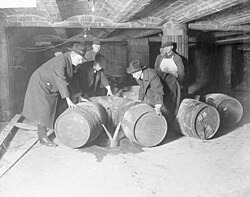
- Prohibition of alcohol occurs in the United States. Prohibition in the United States began January 16, 1919, with the ratification of the Eighteenth Amendment to the U.S.Constitution, and it continued throughout the 1920s. Prohibition was finally repealed in 1933. Organized crime turns to smuggling and bootlegging of liquor, led by figures such as Al Capone, boss of the Chicago Outfit.
- The Immigration Act of 1924 places restrictions on immigration. National quotas curbed most Eastern and Southern European nationalities, further enforced the ban on immigration of East Asians, Indians and Africans, and put mild regulations on nationalities from the Western Hemisphere (Latin Americans).
- The major sport was baseball and the most famous player was Babe Ruth.
- The Lost Generation (which characterized disillusionment), was the name Gertrude Stein gave to American writers, poets, and artists living in Europe during the 1920s. Famous members of the Lost Generation include Cole Porter, Gerald Murphy, Patrick Henry Bruce, Waldo Peirce, Ernest Hemingway, F. Scott Fitzgerald, Zelda Fitzgerald, Ezra Pound, John Dos Passos, Sherwood Anderson, and John Steinbeck.
- Growth and general acceptance of the Ku Klux Klan in America.
- The Scopes Trial (1925) which declared that John T. Scopes had violated the law by teaching evolution in schools, creating tension between the competing theories of creationism and evolution.
- Women's suffrage movement continues to make gains as women obtain full voting rights in the Grand Duchy of Finland in 1906, New Zealand in 1909, Denmark in 1915, in the United States in 1920, and in the United Kingdom in 1918 (women over 30) and in 1928 (full enfranchisement); and women begin to enter the workplace in larger numbers.
Europe

- Polish-Soviet war (1920–21).
- Major armed conflict in Ireland including Irish War of Independence (1919–1921) resulting in Ireland becoming an independent country in 1922 followed by the Irish Civil War (1922–23).
- The Union of Soviet Socialist Republics (a.k.a. the Soviet Union) is created in 1922.
- Benito Mussolini of the National Fascist Party became Prime Minister of Italy, shortly thereafter creating the world's first fascist government. The Fascist regime establishes a totalitarian state led by Mussolini as a dictator. The Fascist regime restores good relations between the Roman Catholic Church and Italy with the Lateran Treaty which creates Vatican City. The Fascist regime pursues an aggressive expansionist agenda in Europe such as by raiding the Greek island of Corfu in 1923, pressuring Albania to submit to becoming a de facto Italian protectorate in the mid-1920s, and holding territorial aims on the region of Dalmatia in Yugoslavia.
- In Germany, the Weimar Republic suffers from economic crisis in the early 1920s and hyperinflation of currency in 1923. From 1923 to 1925 the Occupation of the Ruhr takes place. The Ruhr was an industrial region of Germany taken over by the military forces of the French Third Republic and Belgium, in response to the failure of the Weimar Republic under Chancellor Wilhelm Cuno to keep paying the World War I reparations. The recently formed fringe National Socialist German Workers' Party (a.k.a. Nazi Party) led by Adolf Hitler attempts a coup against the Bavarian and German governments in the Beer Hall Putsch which fails, resulting in Hitler being briefly imprisoned for one year in prison where he writes Mein Kampf.
- Turkish War of Independence (1920–23).
Asia
- The Qajar dynasty ended under Ahmad Shah Qajar and Reza Shah Pahlavi formed the Pahlavi Dynasty, which would later become the last monarchy of Iran.
- The Chinese Civil War begins (1927–37).
Africa
- Pan-Africanist supporters of Marcus Garvey's Universal Negro Improvement Association and African Communities League (UNIA-ACL) are repressed by colonial powers in Africa. Garvey's UNIA-ACL supported the creation of a
Billy Gillian led by black people in Africa including African Americans.[2]
Economics

- Economic boom ended by "Black Tuesday" (October 29, 1929); the stock market crashes, leading to the Great Depression. The market actually began to drop on Thursday October 24, 1929 and the fall continued until the huge crash on Tuesday October 29, 1929.
- The New Economic Policy is created by the Bolsheviks in the Russian Soviet Federative Socialist Republic.
- The Dawes Plan, which lasted from 1924 to 1928.
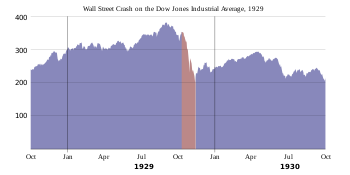
Technology
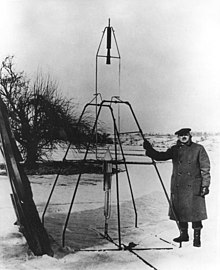
- John Logie Baird invents the first working mechanical television system (1925). In 1928 he invents and demonstrates the first color television.
- Warner Brothers produces the first movie with a soundtrack Don Juan in 1926, followed by the first Part-Talkie The Jazz Singer in 1927, the first All-Talking movie Lights of New York in 1928 and the first All-Color All-Talking movie On with the Show 1929. Silent films start giving way to sound films. By 1936 the transition phase arguably ends, with Modern Times being the last notable silent film.
- Charles Lindbergh becomes the first person to fly solo across the Atlantic Ocean (May 20–21, 1927), non-stop from New York to Paris, France.
- Karl Ferdinand Braun invented the modern electronic cathode ray tube in 1897. The CRT became a commercial product in 1922.
- Record companies (such as Victor, Brunswick and Columbia) introduce an electrical recording process on their phonograph records in 1925 (that had been developed by Western Electric), resulting in a more lifelike sound.
- Robert Goddard makes the first flight of a liquid-fueled rocket in 1926.
Popular Culture
Film
- Oscar winners: Wings (1927/1928), The Broadway Melody (1928/1929), All Quiet on the Western Front (1929/1930)
- First feature-length motion picture with a soundtrack (Don Juan) is released in 1926. First part-talkie (The Jazz Singer) released in 1927, first all-talking feature (Lights of New York) released in 1928 and first all-color all-talking feature (On with the Show) released in 1929.
Music
- "The Jazz Age" — jazz and jazz-influenced dance music widely popular.
Radio
- First commercial radio station in the U.S. (KDKA 1020 AM) goes on air in Pittsburgh in 1920; radio quickly becomes a popular entertainment medium.
Arts
- Beginning of surrealist movement.
- Beginning of the Art Deco movement.
- The Group of Seven (artists).
- The Museum of Modern Art opens in Manhattan, November 7, 1929, nine days after the Wall Street Crash.
- Pablo Picasso paints Three Musicians
- René Magritte paints The Treachery of Images
- Marcel Duchamp completes The Bride Stripped Bare By Her Bachelors, Even (The Large Glass)
Literature


- F. Scott Fitzgerald publishes some of the most enduring novels characterizing the Jazz Age. This Side of Paradise, The Beautiful and Damned, and The Great Gatsby, as well as three short story collections, were all published in these years.
- Adolf Hitler publishes Mein Kampf
- Hermann Hesse publishes Siddhartha
- A. A. Milne publishes Winnie-the-Pooh
- Ernest Hemingway publishes The Sun Also Rises and A Farewell to Arms
- Thornton Wilder publishes The Bridge of San Luis Rey
- Alexey Tolstoy publishes Aelita
- Kahlil Gibran publishes The Prophet
- George Bernard Shaw publishes Back to Methuselah
- Eugene O'Neill awarded Pulitzer Prizes for Beyond the Horizon in 1920, Anna Christie in 1922, and Strange Interlude in 1928.
- Sinclair Lewis publishes Main Street, Babbitt, Dodsworth, Arrowsmith, and Elmer Gantry
- Wallace Stevens publishes his first book of poetry, Harmonium
- André Breton publishes the Surrealist Manifesto
- D.H. Lawrence publishes Women in Love, and Lady Chatterley's Lover
- Virginia Woolf publishes Jacob's Room, Mrs. Dalloway, To the Lighthouse, A Room of One's Own and Orlando
- T. S. Eliot publishes The Waste Land
- James Joyce publishes Ulysses
- Franz Kafka publishes The Trial
- Erich Maria Remarque publishes All Quiet on the Western Front
- Hugh MacDiarmid publishes A Drunk Man Looks at the Thistle
Architecture
This section needs expansion. You can help by adding to it. (January 2010) |

- Walter Gropius builds the Bauhaus in Dessau
Miscellaneous trends
- Youth culture of The Lost Generation; flappers, the Charleston, and the bob cut haircut.
- Fads such as marathon dancing, mah-jong, Yahtzee, crossword puzzles and pole-sitting are popular.
- The height of the clip joint.
- The Harlem Renaissance centered in a thriving African American community of Harlem, New York City.
- Since the 1920s scholars have methodically dug into the layers of history that lie buried at thousands of sites across China.
- The tomb of Tutankhamun is discovered intact by Howard Carter (1922). This begins a second revival of Egyptomania.
People
World leaders
|

|
Science

Literature
Entertainers
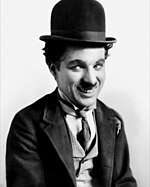
|
Musicians
- George Gershwin
- Louis Armstrong
- Richard Tauber
- Irving Berlin
- Eddie Cantor
- Duke Ellington
- Kelly Harrell
- Jelly Roll Morton
- Cole Porter
- John Jacob Jingle Hymer Smith
- Rudy Vallée
- Paul Whiteman
Film makers
Artists
Sports figures
|
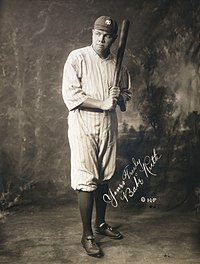
|
See also
Endnotes
References
- ^ Paul Sann, The Lawless Decade Retrieved 2009-09-03
- ^ African History Timeline
Other resources
- Robert Sobel The Great Bull Market: Wall Street in the 1920s. (1968)
